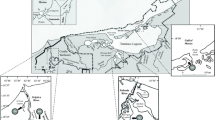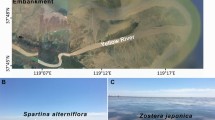Abstract
The assessment of relevant spatial scales at which ecological processes occur is of special importance for a thorough understanding of ecosystem functioning. In coastal ecosystems, the variability of trophic interactions has been studied at different spatial scales, but never at scales from centimetres to metres. In the present study, we investigated the link between habitat structure and small-scale variability of food web functioning on intertidal boulder field ecosystems. Two microhabitats, boulder-top and boulder-bottom, were considered, and the trophic ecology of invertebrate consumers was studied using stable isotope tracers. We found for two of the main suspension feeders of northern Atlantic rocky shores (the sponges Halichondria panicea and Hymeniacidon sanguinea) consistent 15N enrichment for individuals sampled under boulders, suggesting that these consumers relied on different trophic resource according to the microhabitat inhabited, at a centimetre scale. The high δ15N signatures found underneath boulders suggested higher use of highly decomposed organic matter in this microhabitat. The isotopic difference between the two microhabitats decreased in higher trophic level consumers, which likely foraged at a spatial scale including both microhabitats. Finally, our results reveal that in highly heterogeneous habitats such as boulder fields, trophic interactions are likely to vary strongly in space, which should be considered in future researches. The link between habitat physical structure and food web variability might also contribute to the high biological diversity characterizing heterogeneous ecosystems.




Similar content being viewed by others
References
Beck MW (2000) Separating the elements of habitat structure: independent effect of habitat complexity and structural components on rocky intertidal gastropods. J Exp Mar Biol Ecol 249:29–49
Bell JJ (2008) The functional roles of marine sponges. Est Coast Shelf Sci 79:341–353
Bishop MJ, Underwood AJ, Archambault P (2002) Sewage and environmental impacts on rocky shores: necessity of identifying relevant spatial scales. Mar Ecol Prog Ser 236:121–128
Bode A, Alvarez-Ossorio MY, Varela M (2006) Phytoplankton and macrophyte contributions to littoral food webs in the Galician upwelling estimated from stable isotopes. Mar Ecol Prog Ser 318:89–102
Bustamante R, Branch G (1996) The dependence of intertidal consumers on kelp-derived organic matter on the west coast of South Africa. J Exp Mar Biol Ecol 196:1–28
Carlier A, Riera P, Amouroux J-M, Bodiou J-Y, Desmalades M, Grémare A (2009) Spatial heterogeneity in the food web of a heavily modified Mediterranean coastal lagoon: stable isotope evidence. Aquat Biol 5:167–179
Decottignies P, Beninger PG, Rincé Y, Riera P (2007) Trophic interactions between two introduced suspension-feeders, Crepidula fornicata and Crassostrea gigas, are influenced by seasonal effects and qualitative selection capacity. J Exp Mar Biol Ecol 342:231–241
Duggins DO, Eckman JE (1997) Is kelp detritus a good food for suspension feeders? Effect of kelp species, age and secondary metabolites. Mar Biol 128:489–495
Feuchtmayr H, Grey J (2003) Effect of preparation and preservation procedures on carbon and nitrogen stable isotope determinations from zooplankton. Rapid Commun Mass Spectrom 17:2605–2610
Fredriksen S (2003) Food web studies in a Norwegian kelp forest based on stable isotope (δ13C and δ15N) analysis. Mar Ecol Prog Ser 260:71–81
Guest MA, Connolly RM, Loneragan NR (2004) Carbon movement and assimilation by invertebrates in estuarine habitats at a scale of metres. Mar Ecol Prog Ser 278:27–34
Hill JM, McQuaid CD (2008) δ13C and δ15N biogeographic trends in rocky intertidal communities along the coast of South Africa. Evidence of strong environmental signatures. Est Coast Shelf Sci 80:261–268
Hill JM, McQuaid CD (2009) Variability in the fractionation of stable isotopes during degradation of two intertidal red algae. Est Coast Shelf Sci 82:397–405
Kanaya G, Takagi S, Nobata E, Kikuchi E (2007) Spatial dietary shift of macrozoobenthos in a brackish lagoon revealed by carbon and nitrogen stable isotope ratios. Mar Ecol Prog Ser 345:117–127
Kon K, Kurokura H, Hayashizaki K (2007) Role of microhabitats in food webs of benthic communities in a mangrove forest. Mar Ecol Prog Ser 340:55–62
Le Hir M, Hily C (2005) Macrofaunal diversity and habitat structure in intertidal boulder fields. Biodivers Conserv 14:233–250
Lesser MP, Shumway SE, Cucci T, Smith J (1992) Impact of fouling organisms on mussel rope culture: interspecific competition for food among suspension-feeding invertebrates. J Exp Mar Biol Ecol 165:91–102
Levin S (1992) The problem of pattern and scale in ecology. Ecology 73:1943–1967
Mallela J, Harrod C (2008) δ13C and δ15N reveal significant differences in the coastal foodwebs of the seas surrounding Trinidad and Tobago. Mar Ecol Prog Ser 368:41–51
McGuiness KA, Underwood AJ (1986) Habitat structure and the nature of communities on intertidal boulders. J Exp Mar Biol Ecol 104:97–123
Not F, Latasa M, Marie D, Cariou T, Vaulot D, Simon N (2004) A single species Micromonas pusilla (Prasinophyceae) dominates the eukaryotic picoplankton in the Western English Channel. Appl Environ Microbiol 70:4064–4072
Parnell AC, Inger R, Bearhop S, Jackson AL (2010) Source partitioning using table isotopes: coping with too much variation. PLoS ONE 5:e9672
Phillips DL, Gregg JW (2001) Uncertainty in source partitioning using stable isotopes. Oecologia 127:171–179
Riera P (2008) Trophic plasticity in similar habitats: an example which severely limits generalization among ecosystems. JMBA2—Biodiversity Records
Riera P, Escaravage C, Leroux C (2009) Trophic ecology of the rocky shore community associated to the Ascophyllum nodosum zone (Roscoff, France): a δ13C vs δ15N investigation. Est Coast Shelf Sci 81:143–148
Rolff C (2000) Seasonal variation in δ13C and δ15N of size-fractionated plankton at a coastal station in the northern Baltic proper. Mar Ecol Prog Ser 203:47–65
Sarà G, De Pirro M, Romano C, Rumolo P, Sprovieri M, Mazzola A (2007) Sources of organic matter for intertidal consumers on Ascophyllum-shores (SW Iceland): a multi-stable isotope approach. Helgol Mar Res 61:297–302
Schaal G, Riera P, Leroux C (2008) Trophic coupling between two adjacent benthic food webs within a man-made intertidal area: a stable isotopes evidence. Est Coast Shelf Sci 77:523–534
Schaal G, Riera P, Leroux C (2009) Trophic significance of the kelp Laminaria digitata (Lamour.) for the associated food web: a between-sites comparison. Est Coast Shelf Sci 85:565–572
Schaal G, Riera P, Leroux C, Grall J (2010a) A seasonal stable isotope survey of the food web associated to a peri-urban rocky shore. Mar Biol 157:283–294
Schaal G, Riera P, Leroux C (2010b) Trophic ecology in a Northern Brittany (Batz Island, France) kelp (Laminaria digitata) forest, as investigated through stable isotopes and chemical assays. J Sea Res 63:24–35
Steinarsdottir MB, Ingolfsson A, Olafsson E (2009) Trophic relationships on a fucoid shore in south-western Iceland as revealed by stable isotope analyses, laboratory experiments, field observations and gut analyses. J Sea Res 61:206–215
Stephenson RL, Tan FC, Mann KH (1986) Use of stable carbon isotope ratios to compare plant material and potential consumers in a seagrass bed and a kelp bed in Nova Scotia, Canada. Mar Ecol Prog Ser 30:1–7
Thomassen S, Riisgård HU (1995) Growth and energetics of the sponge Halichondria panicea. Mar Ecol Prog Ser 128:239–246
Thornton SF, McManus J (1994) Application of organic carbon and nitrogen stable isotope and C/N ratios as source of organic matter provenance in estuarine systems: evidence from the Tay Estuary, Scotland. Est Coast Shelf Sci 38:219–233
Vanderklift MA, Ponsard S (2003) Sources of variation in consumer-diet δ15N enrichment: a meta-analysis. Oecologia 136:169–182
Acknowledgments
This work was funded by the French National Research Agency (ANR) ECOKELP. G.S. received benefits from a South African National Research Foundation (NRF) and Rhodes University postdoctoral research fellowship. The authors would like to thank Dr Nicole Richoux and two anonymous reviewers, whose constructive comments greatly improved this manuscript. C. Broudin, C. Houbin, V. Ouisse and A. Vettoretti are also thanked for their help during field sampling.
Author information
Authors and Affiliations
Corresponding author
Additional information
Communicated by F. Bulleri.
Rights and permissions
About this article
Cite this article
Schaal, G., Riera, P. & Leroux, C. Microscale variations of food web functioning within a rocky shore invertebrate community. Mar Biol 158, 623–630 (2011). https://doi.org/10.1007/s00227-010-1586-2
Received:
Accepted:
Published:
Issue Date:
DOI: https://doi.org/10.1007/s00227-010-1586-2




